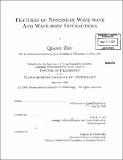| dc.contributor.advisor | Dick K.P. Yue. | en_US |
| dc.contributor.author | Zhu, Qiang, 1970- | en_US |
| dc.contributor.other | Massachusetts Institute of Technology. Dept. of Ocean Engineering. | en_US |
| dc.date.accessioned | 2005-08-23T15:51:05Z | |
| dc.date.available | 2005-08-23T15:51:05Z | |
| dc.date.copyright | 2000 | en_US |
| dc.date.issued | 2000 | en_US |
| dc.identifier.uri | http://hdl.handle.net/1721.1/8853 | |
| dc.description | Thesis (Ph.D.)--Massachusetts Institute of Technology, Dept. of Ocean Engineering, 2000. | en_US |
| dc.description | Includes bibliographical references (leaves 295-302). | en_US |
| dc.description.abstract | Although nonlinear water waves have been the subject of decades of research, there are many problems that remain unsolved, especially in the cases when one or more of the following factors are involved: high-order nonlinear effects, moving boundaries, wavestructure interactions and complicated geometries. In this dissertation, a high-order spectral-element (HOSE) method is developed to investigate problems about nonlinear waves. An exponentially converging algorithm, it is able to be applied to solve nonlinear interactions between waves and submerged or surface-piercing bodies with high-order nonlinear effects. The HOSE method is applied to investigate dynamics of nonlinear waves and their interactions with obstacles. We first implement it to calculate the hydrodynamic forces and moments on a fixed underwater spheroid, with uniform current, different angles of attack and finite water depth included in the study. Extending this study to wave interaction with tethered bodies, we create an efficient simulation capability of moored buoys. Coupling the HOSE method with a robust implicit finite-difference solver of highly-extensible cables, our results show chaotic buoy motions and the ability for short wave generation. We then focus our attention on the free-surface patterns caused by nonlinear wave-wave and wave-body interactions. Starting with a two-dimensional canonical problem about the wave diffraction and radiation of a submerged circular cylinder, numerical evidences are obtained to corroborate that, for a fixed cylinder, a cylinder undergoing forced circular motion, or free to respond to incident waves, the progressive disturbances are in one direction only. The three-dimensional wave-wave interactions are studied. It is proved both analytically and numerically that new propagating waves could be generated by the resonant interactions between Kelvin ship waves and ambient waves. Another consequence of resonant wave-wave interactions is the instability of free-surface waves. In this dissertation, the three-dimensional unstable modes of plane standing waves and standing waves in a circular basin are identified numerically and then confirmed analytically. These investigations cover a large variety of nonlinear-wave problems and prove that the HOSE method is an efficient tool in studying scientific or practical problems. | en_US |
| dc.description.statementofresponsibility | by Qiang Zhu. | en_US |
| dc.format.extent | 302 p. | en_US |
| dc.format.extent | 20991516 bytes | |
| dc.format.extent | 20991267 bytes | |
| dc.format.mimetype | application/pdf | |
| dc.format.mimetype | application/pdf | |
| dc.language.iso | eng | en_US |
| dc.publisher | Massachusetts Institute of Technology | en_US |
| dc.rights | M.I.T. theses are protected by copyright. They may be viewed from this source for any purpose, but reproduction or distribution in any format is prohibited without written permission. See provided URL for inquiries about permission. | en_US |
| dc.rights.uri | http://dspace.mit.edu/handle/1721.1/7582 | |
| dc.subject | Ocean Engineering. | en_US |
| dc.title | Features of nonlinear wave-wave and wave-body interactions | en_US |
| dc.type | Thesis | en_US |
| dc.description.degree | Ph.D. | en_US |
| dc.contributor.department | Massachusetts Institute of Technology. Department of Ocean Engineering | |
| dc.identifier.oclc | 48625778 | en_US |
